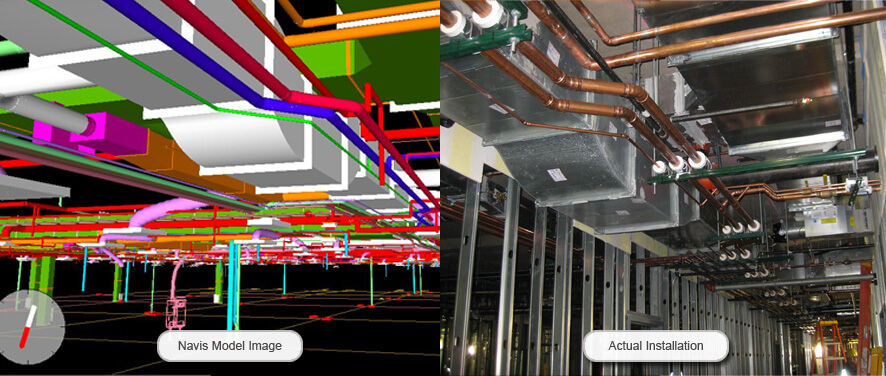Technology

3D MODELING / BIM
Art Plumbing has always placed a high value on pre-installation coordination due to the complex and highly technical nature of the majority of our workload. In addition to minimizing schedule losses due to conflict, we have found that a well coordinated job is a prerequisite for maximizing labor efficiency, thus contributing to quality and value.
We have been at the forefront of our trade when it comes to integrating new technology. The best process that we have found for our coordination efforts is the implementation of the Building Information Modeling (BIM) process. With the use of the latest Auto CAD software and associated 3-D piping and modeling software we are able to streamline the development of the shop drawing process. We currently utilize CAD & FAB-MEP for detailing and “Navisworks” for clash detection.
We currently have eight active CAD stations, and produce accurate and clash free shop drawings on all of our major projects for our field crews to install by.
The key to achieving the enhancements that BIM allows is a carefully scheduled and rigorous design-assist or coordination process. There must be enough time allowed in the preconstruction schedule for the design and construction teams to create an accurate BIM model.
TRIMBLE LAYOUT TECHNOLOGY
A well executed BIM model enables additional productivity gains to be realized via utilization of the Trimble Laser – based layout tool.
We are currently utilizing our Trimble units to increase productivity and simplify the lay out of sleeves and hangers. One person can accurately lay out hundreds of points in a single day … even when the design is complex.
Trimble MEP utilizes the Trimble RTS Series Robotic Stations, a Trimble Nomad, and Trimble MEP layout software to provide our layout crews the precise location of all of our system components contained within the BIM model.
Trimble MEP enables one person to handle layout faster and more accurately than two people using traditional methods. This efficiency results in both a reduction in labor cost and elimination of mistakes that can result in costly re-work.
Trimble MEP enables our layout crews to take 3D positional data to the field digitally, increasing productivity and accuracy by improving layout processes.
As-built point data may also be collected in the field and can be imported back into office CAD/MEP software applications for process reports or to communicate design updates and as-builts.
PREFABRICATION
The utilization of AutoCad and BIM technology in the coordination process has also enabled a more widespread use of prefabrication in the installation process. We are able to confidently prefabricate repetitive assemblies in our shop or at the jobsite with the knowledge that they will fit within space parameters dictated by other building components. Design and/or coordination utilizing BIM technology forces most conflicts to be resolved well in advance of the installation process, eliminating the waste associated with modifying or even completely discarding prefabricated assemblies that were found not to function in the as-built condition.
Most of our opportunities for prefabrication in healthcare facilities are associated with in-wall rough-in piping for sinks, lavatories, and “core” toilets, as well as medical gas outlets and zone valve boxes. Experience has proven that meaningful labor efficiency may be generated by cutting and fitting these repetitive assemblies in the controlled conditions provided by our pre-fab shop or at an on-site pre-fab shop.
We also are able to productively utilize labor during what are normally ‘slow’ periods of installation by performing pre-fab operations while concrete is being poured or steel is being erected, which acts to decrease labor requirements during normally ‘fast’ moving periods such as stud-wall or ceiling grid installation.
The entire prefabrication process helps smooth the work flow and greatly contributes to both quality and schedule enhancement, while at the same time reducing cost.